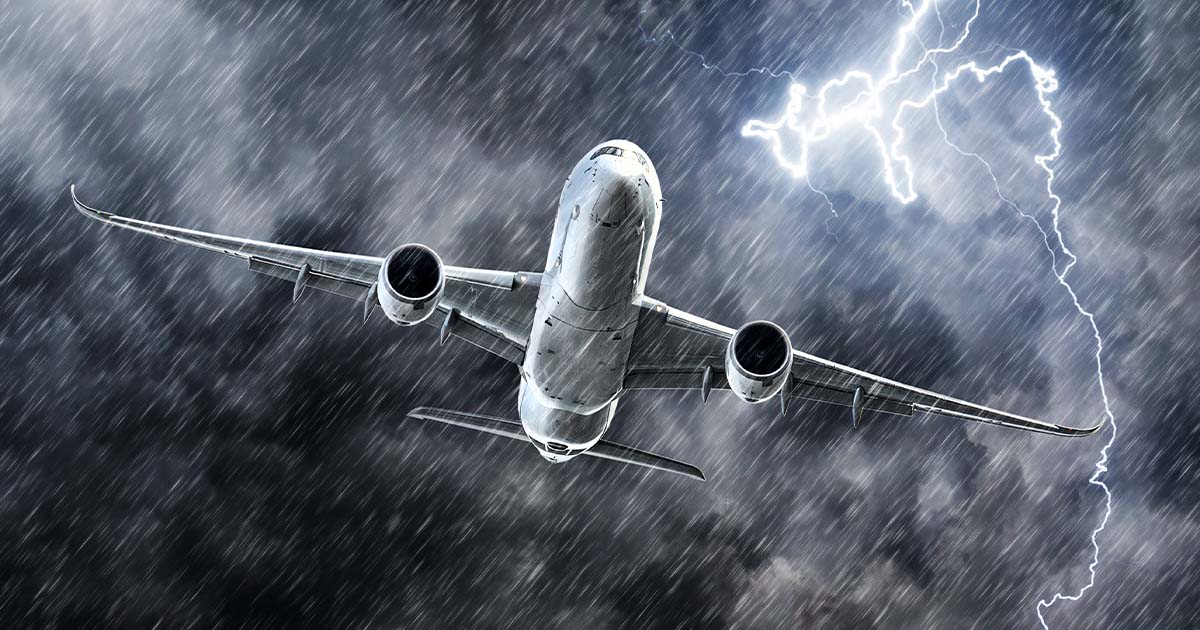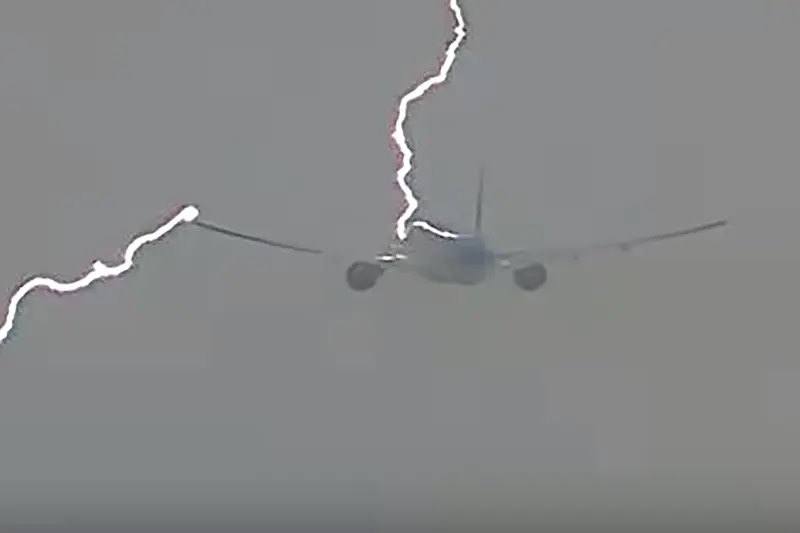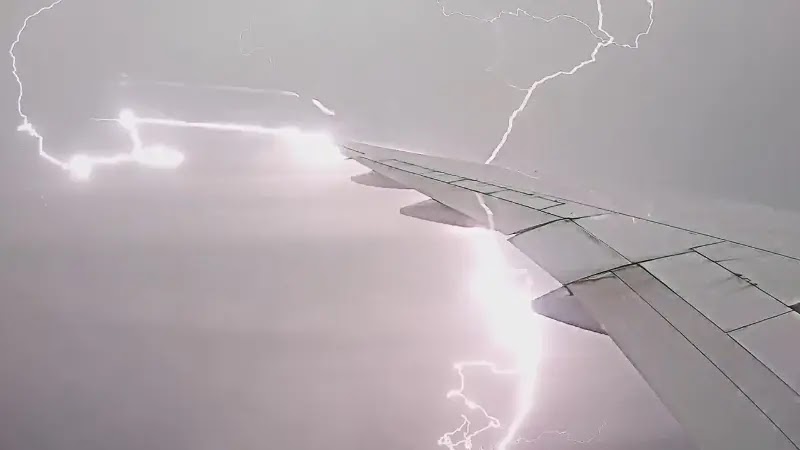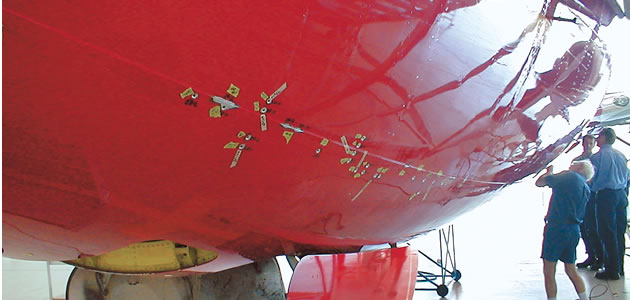
An electrical discharge that happens within a cloud, between two or more clouds, or between a cloud and the Earth’s surface is known as a lightning strike. Nobody wants to fly in extreme storms. Even while it may seem unlikely, lightning strikes planes are far more often than you may expect.
Lightning strikes the Earth around 40 to 50 times every second around the world. It is also known that, on average, more than 100,000 commercial planes take off every day around the world. This means there is more than 1 plane taking off every second!

These numbers show that the probability of lightning striking an airplane is very high. Despite this, no planes have fallen from the sky due to a lack of electricity. Lightning may be dangerous, but how harmful is it to a plane and its passengers? What happens when lightning strikes an aircraft? And what measures do airplanes have to counter lightning strikes?
Accidents of Lightning Striking Planes
According to experts, lightning strikes airplanes on average once per 1,000 hours of flight time.
The last time a lightning strike caused a major disaster was in 1963. In Maryland, the United States, 81 people were killed when a Pan American Boeing 707 got struck by lightning.

It was found that the ignition part that is responsible for the ignition of the gasoline/air combination in the fuel tank was faulty. After the explosion, the outer left wing was lost, and the pilots lost control of the aircraft.
After take-off or landing, most aircraft is struck by lightning at an altitude of between 1,524 and 4,572 meters (5,000 to 15,000 feet). Another element that enhances the likelihood of lightning is the existence of rain in the area. Several systems cannot be rebooted in mid-air; therefore, if lightning strikes an airplane after take-off, it is normally returned to the airport from which it left.
Spring and summer are the most common seasons for lightning strikes. Lightning strikes are less likely to occur at heights greater than 20,000 feet (6,096 meters). Geographical conditions have a role as well, of course. For example, it is more prevalent in the equator than in the Nordics and Florida than on the West Coast of the United States.

Despite the fact that some passengers may find it an uncomfortable experience, modern airplanes are built to withstand lightning strikes. As part of their certification, they are subjected to a series of lightning tests.
How Dangerous is the Lightning Strike for the Airplane?
In most circumstances, lightning strikes on planes do not cause considerable physical damage or affect the plane’s safety. Lightning is more likely to strike the wingtips or the nose of an aircraft.

Afterward, the charge goes through the plane’s metal and exits at a different location, like the tail. It will then go to the other side of the cloud structure. However, if it cannot locate an opposing polarity, it will instead strike a spot on the Earth.
Passengers and crew onboard the airplane may experience a flash and hear a loud blast if the plane is caught up in the cloud-to-ground lightning event. Damage to the plane is determined by various parameters, including the amount of energy discharged during the hit, the position of the hit, the exit points, and the duration of the strike. A single flash of light may deliver up to 30,000 amps or one million volts.

When lightning strikes, it can damage the avionics, including the radar, transmission, and antennas, but it can also penetrate the fuselage and leave a tiny hole in the tail. Additionally, lightning flashes can temporarily blind the flight crew, particularly at night.

In more extreme circumstances, engine shutdown can occur. Occasionally, following a lightning strike, one or more generators may fail, resulting in the loss of cabin lighting.
How Do Airlines Protect their Planes and Passengers?
When a lightning strike occurs, it has the potential to disrupt airline operations, resulting in unnecessary delays and cancellations, and of course, it might lead to the loss of the crew and passengers. In order to avoid such events, maintenance workers must be well-versed in lightning protection, inspection, and repair techniques.

The typical approach for pilots is to stay at least 20 nautical miles away from cumulonimbus (dense cloud location) cloud formations. In addition, new airplanes are engineered to enable lightning to pass over the plane’s surface without causing any harm.

Those are some of the safety guidelines that pilots and maintenance workers are trained to perform. But what about the plane itself? And how does the composition of the plane helps in reducing and maybe eliminating the damage caused by the strike?
Plane’s Composition
As we all know, aluminum conducts electricity, and lightning is more likely to strike a plane’s nose or the tip of its wing. For this reason, these parts are usually made from composite material, even though the plane’s fuselage works as a Faraday cage, shielding the cabin from the voltage as it travels along the container’s exterior.

Source: Teijin
The use of composite and metal components is becoming increasingly common in modern airplanes. The fuselage of the Boeing 787 Dreamliner, for example, is 50 percent composite in weight. 53 percent of the A350 XWB’s airframe is constructed of composite materials.
In contrast to metal, composite materials like carbon fiber laminate do not transmit electricity. As a result, lightning-strike-prone composite parts must be equipped with supplementary lighting precautions. A layer of conductive fibers such as copper foil mesh is used to direct the flow of electricity.
Protect the Fuel from the Spark
It is critical to safeguard gasoline and other combustible compounds from sparks. Lightning bolts may cause serious damage to airplane fuel tanks if they get too close to them. Vents, access doors, and caps must be certified to meet lighting protection regulations.

A bolt of lightning may reach temperatures of up to 30,000 degrees Celsius. However, none of the surrounding metal, structural joints, access doors, vents, or fuel filler caps on an airplane are at risk of being damaged.
These concerns became the norm after the accident of the Pan Am 707 explosion in 1963 that we have already mentioned. An unprotected fuel tank caused the gasses to ignite due to the violent lightning strike. New fuels with fewer harmful fumes have also become commonplace in the airplane industry.
Flying an aircraft that has been struck by lightning requires the pilots to do a thorough check of all systems. Any problems should be resolved by making an emergency landing at the nearest airport.
However, even if the plane reaches its final destination unharmed, its maintenance staff will carefully inspect it upon arrival for any damage. The sites where the lightning entered and exited the fuselage may have developed little holes of less than a centimeter in diameter.
Conclusion
Yes, it is true that lightning strikes on planes are quite common, but nowadays, every modern airplane has been extensively examined and certified to withstand such accidents.
However, even with all these advanced technologies and protection for the plane, the likelihood of extreme turbulence makes it impossible to fly above, beneath, or through storm clouds.
So the next time you have a trip in a bad weather conditions, don’t get afraid of a lightning strike passing through the plane and causing it to explode. The aircraft industry has developed so much over the years, reaching a very high level of safety and protection.




